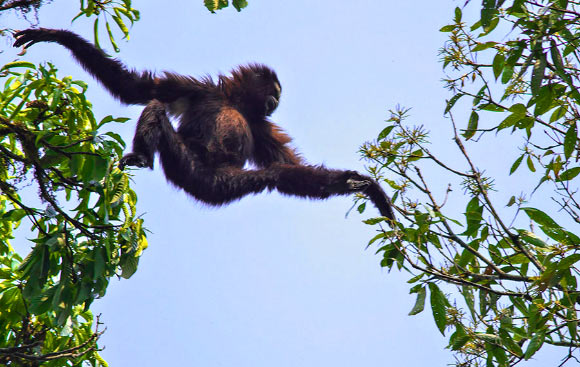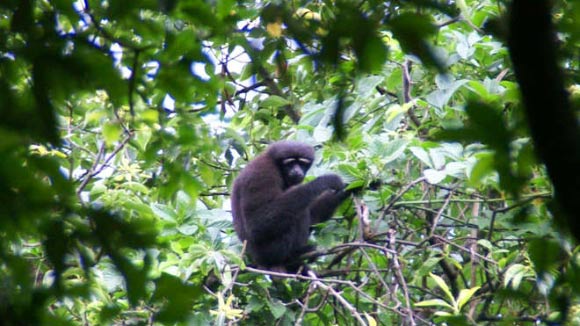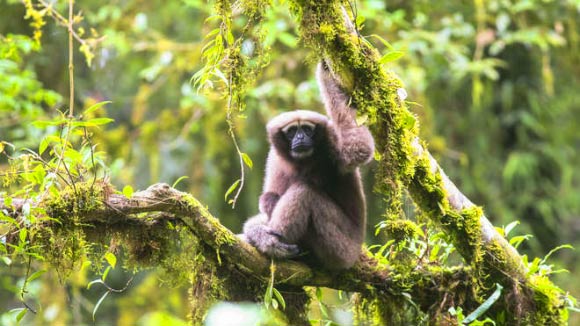A new species of hoolock gibbon has been discovered in eastern Myanmar and southwestern China by an international team of scientists from the United States, the United Kingdom, China, Australia and Germany.

A juvenile male of the Skywalker hoolock gibbon (Hoolock tianxing) from Mt. Gaoligong jumping across trees. Image credit: Lei Dong.
The new species, described in the American Journal of Primatology, has been named the Gaoligong hoolock gibbon or ‘Skywalker’ hoolock gibbon (Hoolock tianxing).
The Star Wars-inspired name reflects the high treetop home of the gibbons, and the historical Chinese view of them as almost mystical beings, according to the team, headed by Sun Yat-sen University Professor Fan Pengfei.
“Gibbons were widely regarded as a symbol of scholar-officials or junzi in ancient China, as the perceived ‘noble’ characteristics of gibbons were considered to accord with the aesthetic taste of both Daoism and traditional Chinese scholars,” the researchers explained.
The new primate belongs to Hoolock, a genus of gibbons that already includes two living species: the western hoolock gibbon (H. hoolock) and the eastern hoolock gibbon (H. leuconedys), geographically isolated by a river.

A male of the Skywalker hoolock gibbon (Hoolock tianxing). Image credit: Zoological Society of London.
Based on assessment of coat color patterns and tooth morphology and a comprehensive study of the genetic characteristics of wild gibbons and museum specimens from an area near Mt. Gaoligong, situated along the border of China and Myanmar, Prof. Pengfei and co-authors believe that hoolocks in this location — previously assigned to H. leuconedys — are actually a distinct hoolock species.
They estimated that Hoolock tianxing genetically diverged from H. leuconedys approximately 490,000 years ago.
“Hoolock tianxing is also distinguished from other described hoolock species by a combination of external and dental characters,” the scientists said.
“In adult males, the ventral pelage is generally dark brown, and the dorsal pelage has a brownish overlay, especially apparent under bright light; eyebrows thin and well-separated; white hairs absent in the suborbital area; beard not conspicuous, black or brown in color, not contrasting with the color of the chest or body.”
“In adult females, pelage color is generally yellowish, but varies with age (yellowish white to reddish blonde); eye rings incomplete; white hair typically not present on the lateral orbital region, or if present, not as conspicuous as on the brows on the lateral orbital region; white hair sometimes also not present on the suborbital region.”
“Juveniles do not have white hair on the chin or under the eyes; eyebrows are not always well-separated,” they said.
“We are thrilled to have made this discovery,” said co-author Dr. Samuel Turvey, from the Zoological Society of London, UK.
“However, it’s also edged with sadness — as we’re also calling for the IUCN to immediately confer Endangered status on Hoolock tianxing, which faces the same grave and imminent risk to its survival as many other small ape species in southern China and Southeast Asia due to habitat loss and hunting.”
“Increased awareness of the remarkable ecosystem of the Gaoligong mountains and improved conservation is essential, to ensure we have time to get fully acquainted with this exciting new species before it’s too late.”
_____
P-F. Fan et al. 2017. Description of a new species of Hoolock gibbon (Primates: Hylobatidae) based on integrative taxonomy. Am J Primatol. 9999: e22631; doi: 10.1002/ajp.22631








